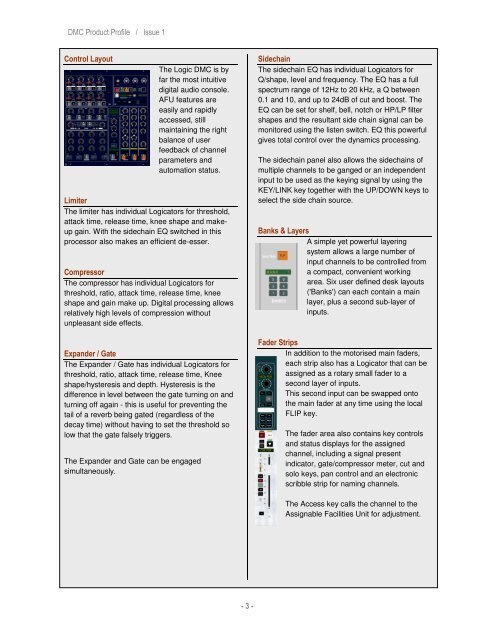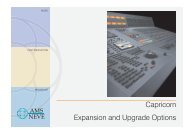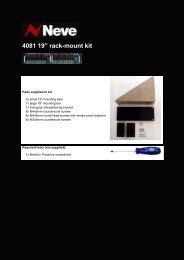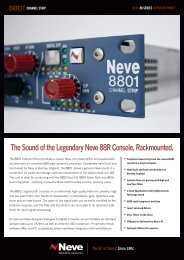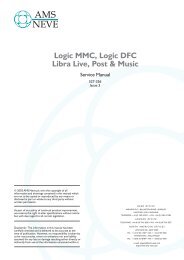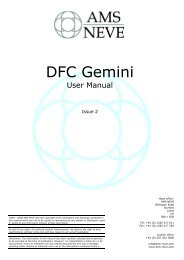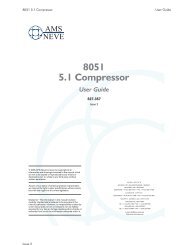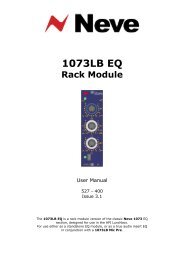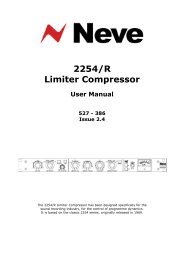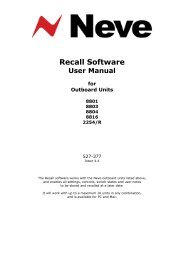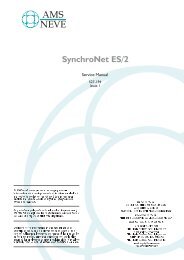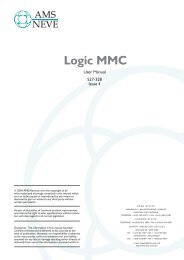DMC Product Profile - AMS Neve
DMC Product Profile - AMS Neve
DMC Product Profile - AMS Neve
You also want an ePaper? Increase the reach of your titles
YUMPU automatically turns print PDFs into web optimized ePapers that Google loves.
<strong>DMC</strong> <strong>Product</strong> <strong>Profile</strong> / Issue 1<br />
Control Layout<br />
The Logic <strong>DMC</strong> is by<br />
far the most intuitive<br />
digital audio console.<br />
AFU features are<br />
easily and rapidly<br />
accessed, still<br />
maintaining the right<br />
balance of user<br />
feedback of channel<br />
parameters and<br />
automation status.<br />
Limiter<br />
The limiter has individual Logicators for threshold,<br />
attack time, release time, knee shape and makeup<br />
gain. With the sidechain EQ switched in this<br />
processor also makes an efficient de-esser.<br />
Compressor<br />
The compressor has individual Logicators for<br />
threshold, ratio, attack time, release time, knee<br />
shape and gain make up. Digital processing allows<br />
relatively high levels of compression without<br />
unpleasant side effects.<br />
Expander / Gate<br />
The Expander / Gate has individual Logicators for<br />
threshold, ratio, attack time, release time, Knee<br />
shape/hysteresis and depth. Hysteresis is the<br />
difference in level between the gate turning on and<br />
turning off again - this is useful for preventing the<br />
tail of a reverb being gated (regardless of the<br />
decay time) without having to set the threshold so<br />
low that the gate falsely triggers.<br />
The Expander and Gate can be engaged<br />
simultaneously.<br />
Sidechain<br />
The sidechain EQ has individual Logicators for<br />
Q/shape, level and frequency. The EQ has a full<br />
spectrum range of 12Hz to 20 kHz, a Q between<br />
0.1 and 10, and up to 24dB of cut and boost. The<br />
EQ can be set for shelf, bell, notch or HP/LP filter<br />
shapes and the resultant side chain signal can be<br />
monitored using the listen switch. EQ this powerful<br />
gives total control over the dynamics processing.<br />
The sidechain panel also allows the sidechains of<br />
multiple channels to be ganged or an independent<br />
input to be used as the keying signal by using the<br />
KEY/LINK key together with the UP/DOWN keys to<br />
select the side chain source.<br />
Banks & Layers<br />
A simple yet powerful layering<br />
system allows a large number of<br />
input channels to be controlled from<br />
a compact, convenient working<br />
area. Six user defined desk layouts<br />
('Banks') can each contain a main<br />
layer, plus a second sub-layer of<br />
inputs.<br />
Fader Strips<br />
In addition to the motorised main faders,<br />
each strip also has a Logicator that can be<br />
assigned as a rotary small fader to a<br />
second layer of inputs.<br />
This second input can be swapped onto<br />
the main fader at any time using the local<br />
FLIP key.<br />
The fader area also contains key controls<br />
and status displays for the assigned<br />
channel, including a signal present<br />
indicator, gate/compressor meter, cut and<br />
solo keys, pan control and an electronic<br />
scribble strip for naming channels.<br />
The Access key calls the channel to the<br />
Assignable Facilities Unit for adjustment.<br />
- 3 -


